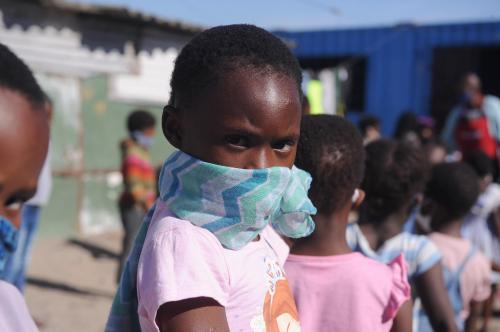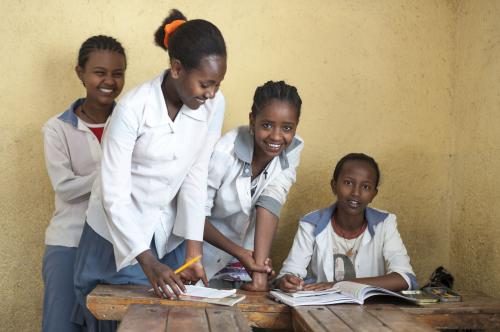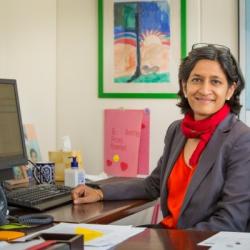This week, as we approach International Women’s Day, government leaders are gathering at the World Bank Global Forum on Human Capital discussing, among other things, the importance of investing in women and girls in Africa. As countries struggle to control the COVID-19 pandemic, save lives, and rebuild economies, such investments are more important than ever and, in fact, will lead to a more resilient and inclusive recovery for all.
Every day, adolescent girls in sub-Saharan Africa face barriers caused by cultural norms, practices, and biases that limit their access to economic and social opportunities relative to boys, including health care and education services. COVID-19 has exacerbated these challenges, with girls and women disproportionately affected by the economic impacts and disruptions in core services caused by pandemics.
For example, following school closures during the 2014-2016 Ebola crisis, many girls did not return to school, and teenage pregnancies rose. COVID-19 threatens similar increases in school dropouts, child marriages, adolescent childbearing, and gender-based violence. These terrible outcomes not only shatter lives and aspirations and limit opportunities for girls to achieve their full potential, but they also harm their children. Indeed, children of young and poorly educated mothers often face higher risks of dying by the age of five, being malnourished, and doing poorly in school.
Investing in adolescent girls in Africa and around the world pays dividends.
Conversely, investing in adolescent girls in Africa and around the world pays dividends. Each additional year of schooling raises an African woman’s earnings by 14 percent, reduces the likelihood of early marriage and pregnancy, and can lead to higher standards of living. Investments in programs focused on adolescent girls, from life skills and vocational training, to sexual and reproductive health, to behavioral interventions and cash transfers are delivering results.
These types of programs have an important role to play given the expected sharp increase in Africa’s working age population over coming decades. They can help the region achieve a demographic transition—a shift from high to lower birth rate accompanied by improved income opportunities—to reap the benefits of a demographic dividend.
At the World Bank our Human Capital Plan for Africa places women and girls at the center of an integrated approach to drive transformational change. Since its launch in 2019, we have already added over $2.2 billion of new investments in African women’s agency, health, education, and employment opportunities.
The plan aims to achieve ambitious targets in child survival, reduced stunting, improved learning, stronger social protection, and lowered adolescent fertility. It identifies key “game changers” including accelerating the demographic transition through a new series of projects empowering women across the region. For example, in the Sahel region, where 1 in 2 girls is married before the age of 18, the Sahel Women’s Empowerment and Demographic Dividend project is empowering women and adolescent girls across nine countries by helping adolescent girls through providing sexual and reproductive health knowledge, which helps keep girls in school, expand their economic opportunities, and prevent gender-based violence. The project has helped train over 6,600 midwives across the Sahel where maternal health has been woefully underserved. In Mali, for instance, there were 2,657 midwives and obstetric nurses across the entire country, representing 1.4 midwives for every 10,000 inhabitants, well below the World Health Organization recommended standard of 23 per 10,000 inhabitants. The project—which engages the entire community from religious leaders, legislators, health workers, and husbands—has seen such encouraging results for girls and women that it is being scaled up further in the Sahel and in neighboring countries. Project investments are also supporting development of quality remote learning platforms to keep all students engaged in learning and help prevent vulnerable girls from dropping out. For example, in Nigeria, a lack of schools, poor infrastructure, and the inability to cover the costs of schooling present many constraints for adolescent girls in accessing and completing secondary school. It is estimated that, without action, 1.3 million girls of the 1.85 million who began primary school in 2017-2018 will drop out before completing secondary school. The Adolescent Girls Initiative for Learning and Empowerment project aims to use schools as a platform to empower girls in Nigeria through education, life skills, self-agency, and digital literacy skills. In response to COVID-19, the project has been adapted to support a blended learning approach using technology and media.
In addition to education and improved access to adequate health services for girls, projects invest in local economic development programs. Technology and innovations in service delivery are helping with the crisis today but also present enormous opportunities for improving systems for tomorrow. In the Central African Republic, for example, a multisectoral project is empowering girls to make lifesaving and life-enhancing choices for themselves, their families, and their communities through formal and vocational training for adolescents that are expected to lead to reduced rates of maternal mortality and early pregnancies.
This pandemic is setting back Africa’s human capital and risks wiping out a decade of human capital gains. But this crisis also brings a motivation to act—not just to protect the hard-won advancements achieved, but also to better prepare for the future. Putting girls front and center in the collective COVID-19 response will ultimately lead to a stronger, more resilient, and inclusive recovery.
The Brookings Institution is committed to quality, independence, and impact.
We are supported by a diverse array of funders. In line with our values and policies, each Brookings publication represents the sole views of its author(s).







Commentary
Putting girls at the center of the COVID-19 pandemic response in Africa
March 5, 2021